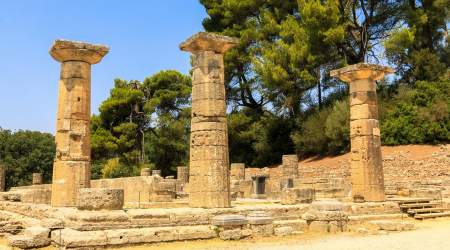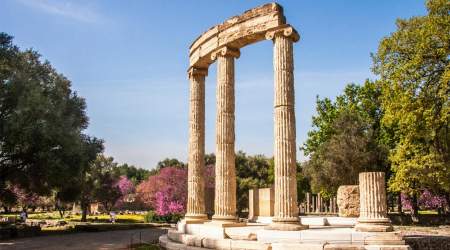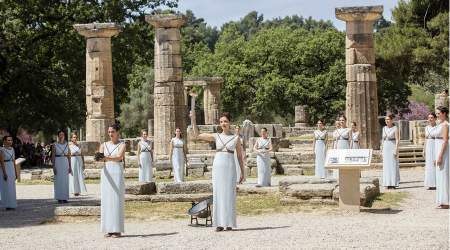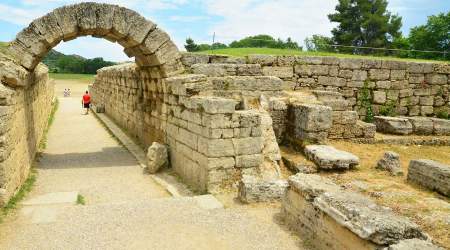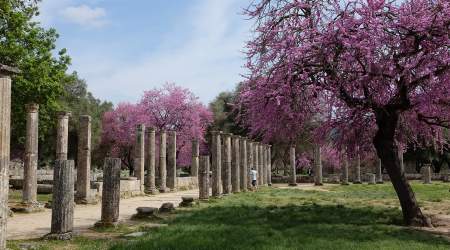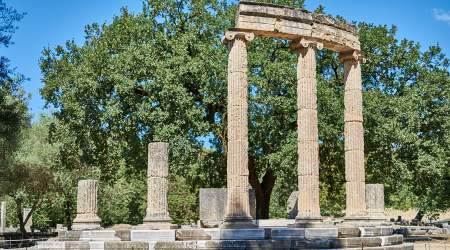Archaeological site of Ancient Olympia
Archaeological site of Ancient Olympia
Ancient Olympia did not always look the way it does today, nor did it look the same through the centuries. During some periods new buildings were erected, while the older ones continued to function. The present aspect of the archaeological site reflects the final phase of the sanctuary’s history, prior to its destruction. At the centre of the Altis stood the religious edifices, the three temples ( Heraion, Temple of Zeus and Metroon), the larger altar where sacrifices were made, and the tumulus of Pelops. Along their perimeter were buildings necessery to support the sanctuary’s operation, including hosting the games.
It is recommended that visitors begin their tour of the archaelogical site from the Prytaneion and the Philippeion. Directly in front is the Heraion , to the left is the Nymphaion and just past that is the terrace with the Tresuries. Visitors should proceed to the Metroon, and the Stadium. To the Southest of the Stadium is located the Hippodrome, of which survives since it was washed away by the waters of the Alpheios river.
Beyond the Stadium is the Stoa of Echo. Directly opposite, visitors can see the Pelopion and then continue towards the temple of Zeus and the Pedestal of the Nike the Paionios. Visible for the distanceare the Southest Building and the Octagon, part of the roman villa complex built by Nero. To the South of the Temple are the Bouleuterion and the South Stoa. In the Southwest corner is the Leonidaion, behind which the remains of the Roman bath installations stand.
On the west side of the archaeological site, visitors pass by the Workshop of Pheidias, where the well-known sculpture curved the Ivory Gold statue of Zeus, one of the 7 wonders of the ancient world. On the west side also is located the Heroon and the Theokoleon. Further west are the Kladeos Baths. Directly in front of the visitor stands the columns of the Palestra and the Gymnasium with the magnificent propylon.
History of Olympia
Olympia the birthplace of the Olympics that was a sanctuary dedicated to Zeus. The first games were held in the 2nd millennium B.C. and had a local character. The organization and the conduct of the games were the responsibility of the Eleian hellanodikai, who were elected by drawing lots from among all Eleian men. Only free Greek males were eligible to participate in the games. Barbarians, slaves and women were banned. In 776 B.C. the first Panhellenic games were organized in Olympia because during the games all the wars between the Greek city-states had to stop, so there was peace around Greece.
The games were held in every 4 years in honour of the father of gods and men, Zeus, similarly , the Pythian games at Delphi were held in honour of Apollo, and so on. In the beginning, they lasted for a day since the athletes could participate in one foot-race. Later on in the 5th B.C, c. the games lasted for 5 days. In the first day many sacrifices dedicated to Zeus were held in the sanctuary. The second, third and fourth were the days that the games were held in the stadium and the hippodrome. And the fifth it was the day that the Olympic winners were finally crowned with a wreath that they made from a brunch of an olive tree.
The games continued to take place during the Greek and Roman era until the 4th A.D. c. In 393 A.D. Theodosius I abolished the games because the Christian faith was established in the Roman Empire.
From the 4th A.D. c. we had to wait until the 19th c. in 1896 when the first modern games were held at the Panathenaic stadium of Athens and were organized by a Frenchman Baron Pierre De Coubertin.

